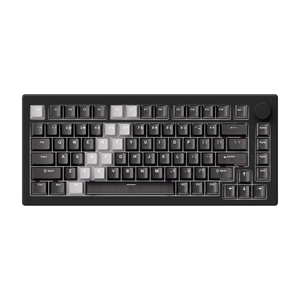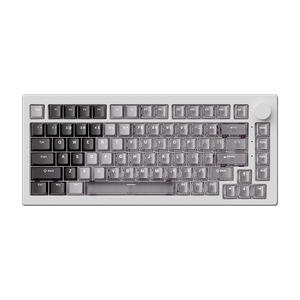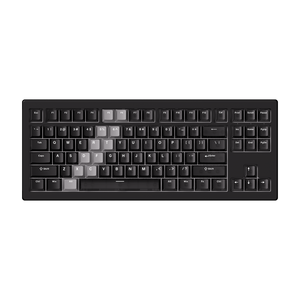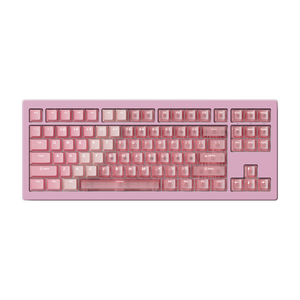What should you consider when buying a gaming mouse ? Two important specifications that are often discussed are DPI (dots per inch) and polling rate. But does "higher" always mean better? Today we'll take a look at what polling rates are and how they affect your gaming performance.
What is the polling rate of a mouse?
The mouse polling rate describes the frequency of communication between the mouse and the computer per second, measured in Hz. The mouse continuously "reports" its current position and actions to the computer. For a movement or skill to be executed in the game, the player must wait for the computer to receive the mouse report to confirm that the action was performed.
For example, a mouse with a polling rate set to 125 Hz will update its position on the screen 125 times per second. A higher polling rate reduces the delay between mouse movements and on-screen actions. This is exactly what our Pulse 01 Gaming Mouse does, with a polling rate of 8000 Hz in both 2.4G and wired modes. It increases data throughput by 8x, ensuring virtually zero latency. However, at common polling rates, there is a millisecond delay.
Polling rate (Hz) and millisecond latency (ms):
| Polling rate (Hz) | Millisecond latency (ms) |
| 125 Hz | 8 ms |
| 250 Hz | 4 ms |
| 500 Hz | 2 ms |
| 1000 Hz | 1 ms |
| 4000 Hz | 0.25 ms |
| 8000 Hz | 0.125 ms |

What is the best polling rate for gaming mice?
The majority of standard mice have a polling rate of 100, 125, or 250 Hz. A 0.1 second delay is insignificant for tasks that don't require rapid response, such as working on documents or playing casual games. However, even a small input delay caused by a low polling rate can significantly impact the gameplay and performance of esports players. So, what is the best polling rate for gaming?
The best polling rate for a mouse should depend on the type of game. Higher polling rates significantly reduce input lag, which is especially beneficial for fast-paced esports titles. However, games like RPGs and strategy games don't necessarily require such high polling rates.
- For fast-paced, competitive games, esports, and professional gaming, a 1000 Hz polling rate is very beneficial. If possible, an 8000 Hz polling rate is even better for fast speeds.
- For MOBA games (e.g., League of Legends) and real-time strategy games, a 500 Hz polling rate offers a good mix of responsiveness and stability. However, if you're playing at a high level, a 1000 Hz polling rate can provide a slight advantage in precision, supporting quick movements and fine control during intense moments.
- For less demanding games like RPGs, casual games, or single-player titles, a polling rate of 250 Hz to 500 Hz is usually sufficient. These games often don't require split-second responses, so the benefits of a higher polling rate may not be noticeable. A lower polling rate also places less strain on the CPU, which can be beneficial for older systems.
However, we don't recommend choosing a polling rate below 500 Hz, as input lag greater than 1 ms becomes perceptible to the human eye. Furthermore, most gaming monitors mitigate input lag variations caused by the mouse. Therefore, if your monitor's refresh rate is higher than 120 Hz, you should avoid a polling rate below 500 Hz.
In summary, depending on the game, a polling rate of 500 Hz to 1000 Hz is ideal.

Is a higher query rate better?
As discussed above, a higher polling rate is beneficial for a gaming mouse. A higher polling rate is often considered better because it reduces input lag, especially when considering input lag and the monitor's refresh rate. In this context, a higher polling rate can actually make the gaming experience more responsive. The higher the polling rate, the faster the response.
In reality, however, the difference in latency between a 500 Hz and a 1000 Hz polling rate is only 1 ms—and that's at the limit of what most people can actually perceive. Perhaps most people won't notice the significant difference between these two rates.
Additionally, polling rates of 1000 Hz or higher can place greater demands on the CPU. While this isn't a problem for modern processors and won't affect most systems, users of older CPUs may encounter issues at ultra-high polling rates. In such cases, choosing a more moderate polling rate is often a better choice.
On older machines or systems with less powerful CPUs, keep the polling rate between 250 Hz and 500 Hz to avoid unnecessary strain on the hardware. This setting ensures smooth operation without placing excessive strain on the system, providing a balance between performance and responsiveness.
How can I determine my mouse's polling rate?
You can usually find out your mouse's polling rate by checking the manufacturer's product specifications. You can also use software provided by the manufacturer to check your mouse's polling rate. There are also third-party tools you can use to test the polling rate.
For online polling rate testing tools, you can use sites like TestUFO, MouseDPAnalyzer, and DeviceTests. These tools are easy to use and provide you with an accurate polling rate for your mouse.
Of course, you can also download third-party software like "Mouse Rate Checker" or "Direct Input Mouse Rate" to check your mouse's polling rate. These programs measure the polling rate by tracking mouse input data in real time.
How do you change the polling rate of a gaming mouse?
Polling rate is crucial for optimizing precision and responsiveness, making it a key factor in gaming performance. Higher polling rates can improve response times and accuracy, but finding the right balance is important to avoid unnecessary strain on the system. Therefore, it's important to adjust the polling rate for your mouse. If your mouse is from Akko, you can easily adjust the polling rate using our cloud driver.
1. First, you can download the Akko Cloud Driver or the AG One NearLink Driver from our download page .
2. You can easily find the polling rate setting under " Performance " and apply the changes.

Conclusion
A high mouse polling rate will improve responsiveness and speed, especially in fast-paced games. However, this isn't always necessary in all situations. A moderate polling rate often offers an excellent compromise between system load and performance for everyday use or light gaming. To ensure the best experience, your decision should ultimately be balanced between the game's requirements, system capabilities, and your personal preferences.















